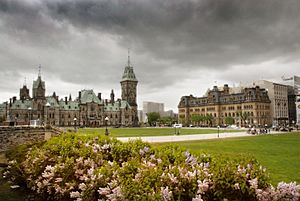Office of the Prime Minister and Privy Council facts for kids
Quick facts for kids Office of the Prime Minister and Privy Council |
|
|---|---|

The building seen from Wellington Street in 2010
|
|
| Former names | Southwest Departmental Building, Langevin Block |
| General information | |
| Type | Office building |
| Architectural style | Second Empire |
| Address | 80 Wellington Street |
| Town or city | Ottawa, Ontario |
| Country | Canada |
| Current tenants | Office of the Prime Minister Privy Council Office |
| Construction started | 1884 |
| Completed | 1889 |
| Owner | The Queen in Right of Canada |
| Landlord | National Capital Commission |
| Design and construction | |
| Architect | Thomas Fuller |
| Designations | Classified Federal Heritage Building |
| Official name: Langevin Block National Historic Site of Canada | |
| Part of: | Confederation Square National Historic Site of Canada |
The Office of the Prime Minister and Privy Council building is an important office building in Ottawa, Ontario, Canada. It faces Parliament Hill, which is where Canada's main government buildings are located. This building is the working home for the Privy Council Office and the Office of the Prime Minister. This means it's a key place for the people who lead the Canadian government.
This building was once known as the Langevin Block. It was named after Hector-Louis Langevin, who was a cabinet minister and one of the "Fathers of Confederation." However, in 2017, the name was changed. This happened because Indigenous people raised concerns about Hector Langevin's connection to the residential school system. This system caused great harm to Indigenous children and families in Canada's history. To show respect and acknowledge this past, Prime Minister Justin Trudeau announced the new name on June 21, 2017.
The building is also recognized as a National Historic Site of Canada. This means it's an important part of Canada's history and heritage.
What Happens Inside?

Today, the building is mostly used by the Prime Minister's Office. The Prime Minister also has an office in the Centre Block of the Parliament Buildings. Some senior officials from the Privy Council Office also work here.
A Look at the Building's History
Construction on this building began in 1884 and finished in 1889. It was special because it was the first federal government office building built outside the main Parliament Hill area. The building is made from sandstone, which came from a quarry in New Brunswick.
It stands out on Ottawa's Wellington Street. It's close to many other famous landmarks like the National War Memorial, the Château Laurier, and the Rideau Canal. When it was being built, it was called the Southwest Departmental Building. After it was finished in 1889, it was named after Sir Hector-Louis Langevin. He was the Public Works Minister at the time.
The building has a unique look for Ottawa. Most government buildings from that time were built in the Gothic Revival style. But this building was designed in the Second Empire Style. The Chief Dominion Architect, Thomas Fuller, designed it. He also designed the original Parliament Buildings. In 2000, the Royal Architectural Institute of Canada named it one of the top 500 buildings in Canada from the last thousand years. There's even a bridge that connects it to another office building nearby.
In 2017, the Assembly of First Nations asked for the building's name to be changed. This was because of Hector Langevin's connection to the Indian residential schools system. On June 21, 2017, the building was officially renamed the Office of the Prime Minister and Privy Council.

